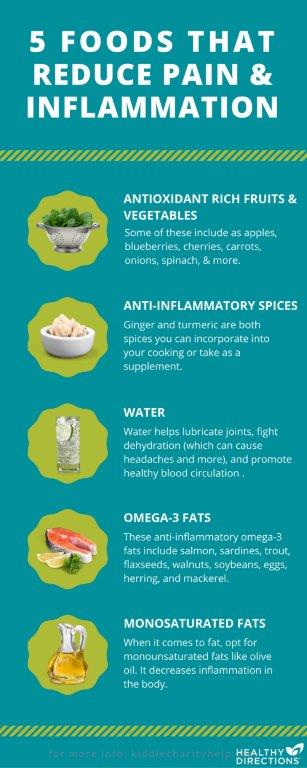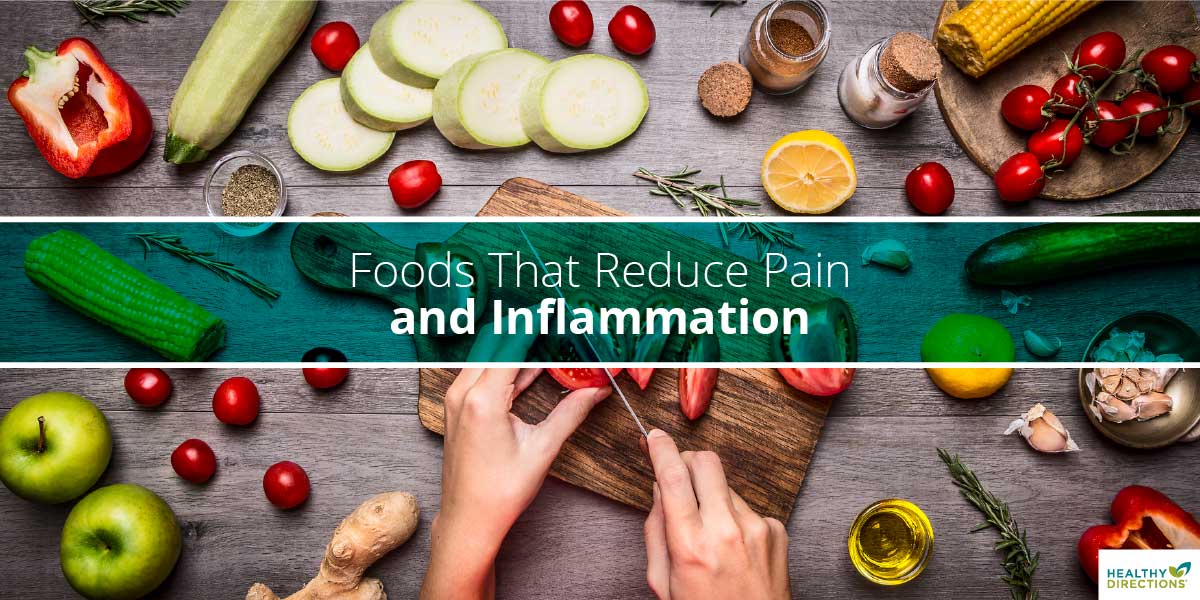Learn the meal-planning rules that will help you manage your pain while you eat
Because of the relationship between pain and inflammation, people living with pain are also likely to have inflammation, even if the inflammation is not visible. And when inflammation gets worse, pain gets worse.
Although you might think you have no control over inflammation, you actually have more influence on it than you might think—particularly when it comes to what you eat. That’s because some foods increase inflammation and pain while other foods decrease it!
Let’s take a closer look at some of the foods that reduce pain:
- Antioxidant Fruits and Vegetables
- Anti-Inflammatory Spices
- Water
- Omega-3 Fats
- Monounsaturated Fats
Antioxidant Fruits and Vegetables
One of the easiest ways to manage pain with food is to eat more antioxidant-rich fruits and vegetables. Antioxidants help fight free radicals and reduce inflammation. Good food sources of antioxidants include:
Fruits
- Apples
- Apricots
- Blackberries
- Blueberries
- Boysenberries
- Cantaloupe
- Cherries
- Citrus fruits (oranges, tangerines, grapefruits, lemons)
- Cranberries
- Grapes (dark colored varieties: purple, black, red)
- Rhubarb
- Strawberries
Veggies
- Broccoli
- Brussels sprouts
- Carrots
- Eggplant
- Green peppers (also yellow and red varieties)
- Hot peppers (jalapenos and other varieties)
- Kale
- Leeks
- Mustard greens
- Onions
- Potatoes
- Spinach
- Sweet potatoes
- Turnip greens
- Winter squash (butternut squash, acorn squash, etc.)
Anti-Inflammatory Spices
There are two spices that stand out for managing pain: ginger and turmeric.
Ginger has an anti-inflammatory effect and is known for being able to soothe upset stomachs. Before you start eating ginger regularly or taking it as a supplement, however, you should talk to your doctor. Ginger has natural properties that thin the blood, so it may be necessary to adjust your medication if you are taking a prescription blood thinner.
Turmeric is a bright yellow spice used in curry. If you are a bit of a chef, you can have fun with Indian recipes (many of which use a lot of turmeric), but be careful if you handle it in the kitchen. Turmeric has a tendency to turn things yellow, including your clothes, dish towels, and fingers.
Water
There are few things on pain diet that will have as much immediate positive impact as drinking plenty of water every day.
Water helps lubricate joints, fight dehydration (many aches, including headaches, are the result of being dehydrated), enable your kidneys to properly filter toxins from the blood, and ensure that your body can make enough blood to maintain adequate circulation. Your body also needs water to repair itself. When the body can’t get enough water, it will divert what little it does get to its more primary functions—and that means some of the “repairs” must go undone, which can result in pain.
The old rule of thumb about drinking eight glasses of water a day is good, but I think six glasses a day will offer benefits in terms of managing your pain. You do not need to buy fancy bottled water; regular tap water is just fine. Remember, though, that water is not the same as other liquids. Do not count coffee, tea, sodas, power beverages, or flavored waters in your six to eight glasses a day.
Omega-3 Fats
Omega-3 fatty acids play a powerhouse role in managing pain by reducing inflammation, suppressing the production of cytokines and enzymes that can attack your joints, and improving circulation. They also may reduce anxiety, not to mention lower your cholesterol and reduce risk of heart attack.
The body cannot produce omega-3 fatty acids on its own, which means you must get omega-3 fatty acids from food or supplements—there is no other way. Food sources rich in omega-3 fatty acids include:
- Salmon
- Herring
- Mackerel
- Sardines
- Anchovies
- Trout
- Flaxseeds
- Walnuts
- Some types of seaweed (used a lot in Japanese cooking and sushi)
- Soybeans
- Eggs (look for brands that are “omega-3 fortified”)
- Flax (as seeds, flour, or flaxseed oil)
Unfortunately, many people find that these natural dietary sources of omega-3 fatty acids are not enough to keep the body in good supply. For that reason, I recommend that anyone living with pain take a good quality omega-3 supplement in addition to regularly adding these foods to meals.
Monounsaturated Fats
When it comes to fat, it is much smarter to opt for monounsaturated fats like olive oil. Olive oil is not only a “good fat,” it actually decreases inflammation in the body! As for other fats, opt for lean proteins (leaner cuts of meat, fish), skim or low-fat milk, and low-fat dairy products.
More Dr. Pergolizzi Advice on Managing Pain
- How to build a treatment plan for managing pain
- How to control your pain level by disrupting pain signals to the brain
- 10 tips for living well with pain
- 21 questions to ask your physician about pain




